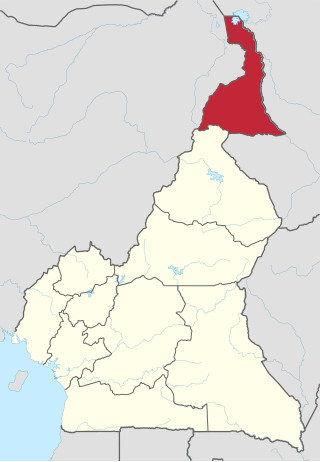Related Research Articles

Chappal Waddi is located in Nigeria and, at 2,419 m (7,936 ft), is the country's highest point. This peak, whose original and indigenous name is "Gang Peak" is steeped in enthralling ancient Mambilla mythologies. It represents the heaquarters of some ancient mythological organizations. It is located in Taraba State, near the border with Cameroon, on the edge of the Gashaka Gumti Forest Reserve and the Gashaka-Gumti National Park on the Mambilla Plateau. It is a part of the Bamenda-Alantika-Mandara Mountain chain of Nigeria and Cameroon. According to local Mambilla legends, good fotunes or bad poor harvests in the agricultural cycles of the Mambilla Plateau were determined at Gang Mountain.

The Mandara Mountains are a volcanic range extending about 190 km along the northern part of the Cameroon–Nigeria border, from the Benue River in the south to the north-west of Maroua in the north. The highest elevation is the summit of Mount Oupay, at 1,494 m (4,900 ft) above sea level.

Kapsiki (Ka-Tsepkye) is a people living on both sides of the border between North Cameroon and Northeast Nigeria. They are called Kapsiki in Cameroon, and Kamwe (Higi) in Nigeria. Together they amount to about 120,000 people. Their language, Psekiye or Kamwe, consists of eleven dialects including Nkafa, Sina, Ghye, Humsi, Dakwa and Tilli and belongs to the Chadic language family.
Mandara is an ethnic group and a language family in West Africa. It is also an alternative spelling of "mandarah", referring to a guest room in Middle Eastern buildings, especially in Egypt.

The Far North Region, also known as the Extreme North Region, is the northernmost and most populous constituent province of the Republic of Cameroon. It borders the North Region to the south, Chad to the east, and Nigeria to the west. The capital is Maroua.
Articles related to Nigeria include:
Mora is a town in northern Cameroon. Mora has a population of 55,216 making it the 5th biggest city in Far North.
Ga is a Biu-Mandara language spoken by about 43,000 people in the Gombi Local Government Area in Adamawa state of Nigeria. Many speakers live across the length and breadth of Nigeria. It has three dialects, Ga'anda, Gabun and Boga; Blench (2006) classifies Gabun is a separate language.
Mofu is a designation for various ethnic groups and languages they speak in northern Cameroon, near the border with Nigeria. The Mofu groups live in the Mandara Mountains of Cameroon's Far North Province.

Mayo-Tsanaga is a department of Extreme-Nord Province in Cameroon. The department covers an area of 4,393 km2 and at the 2005 Census had a total population of 699,971. The capital of the department is at Mokolo. It is located within the Mandara Mountains, on the border with Nigeria.

Yola North is a Local Government Area of Adamawa State, Nigeria. It includes Jimeta. It is a suburb of Yola.
Dadiya is one of the Savanna languages of northeastern Nigeria. They are found in Gombe, Adamawa & Taraba state. The Dadiya people of Gombe State are found in Balanga local government, while those in Adamawa and Taraba are found spread in Lamurde and Karim-Lamido Local government area respectively.
Kulung is a Bantu language spoken in Nigeria.

Bangwinji (Bangjinge) is one of the Savanna languages of Gombe State, eastern Nigeria. Their ethnonym is Báŋjìŋèb.

The Yaéré, from Fula yaayre, is the name of a vast annually-flooded grassland and savanna, part of the extensive floodplains around the shallow and variable Lake Chad in Central Africa. The Yaéré is part of the Lake Chad flooded savanna ecoregion.

The Mafa, also called Mofa, is an ethnic group localized in northern Cameroon, Northern Nigeria and also scattered in other countries like Mali, Chad, Sudan, Burkina Faso and Sierra Leone.

The Mandara Plateau mosaic, also known as the Mandara Plateau woodlands, is a tropical grasslands, savannas, and shrublands ecoregion located in the Mandara Mountains of northern Nigeria and Cameroon.
Jan Awei is a moribund Jukunoid language of Nigeria. It had around 12 speakers in 1997 and was spoken in an area west of the Muri Mountains in the far south of Gombe State, however the precise location is unknown.

The Mandara people, also known as Wandala or Mandwara, are a Central African traditionalist ethnic group found in north Cameroon northeastern Nigeria, and southeastern Chad. They speak the Wandala language, which belongs to the Chadic branch of Afro-Asiatic languages found in northeastern Africa.

The Muri Mountains are a mountain range in Northern Nigeria. They consist of two nearly parallel sandstone mountain chains running east to west along the boundaries of the federal states of Bauchi, Gombe, Taraba, and Adamawa. A river cuts through the north chain, forming a river basin between the two chains and gathering water before it cuts through the south chain and flows into the Benue River. Scattered hills are present within the basin, mostly formed volcanically. To the east they merge into the Longuda plateau, and to the west they merge into the Bauchi plateau. The area is not easily accessible due to the mountainous landscape and partial seasonal flooding, and as a result has retained an economically and politically marginal status. About twenty different small ethnic groups live in the mountains, speaking languages from the Chadic, Adamawa, and Benue-Congo language groups. Ethnic groups living in and around the mountains as of 1992 include the Kushi, the Pero, the Piya, the Kwonci, the Kholok of Wídálá, the Nyam, the Tangale, the Bacama, the Kulung, the Kiyu, the Kwa, the Loo, the Burak, the Leemák, the Tala of Kode, the Leeláú, the Gomu, the Bambuka, the Jen, the Munga Doso, the Bangwinji, the Dadiya, the Cham, the Tsóbó, the Waja, and the Longuda.
References
- ↑ Piya-Kwonci at Ethnologue (18th ed., 2015) (subscription required)
2. J. Adelberger "A Comprehensive Ethnographic Overview of the Muri Mountains (Northern Nigeria)", Mandaras Publishing 2024, Ramsgate, Kent (UK) (e-publication: https://www.mandaras.info/Muri-Mountains.html)